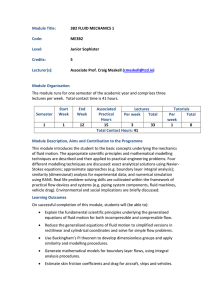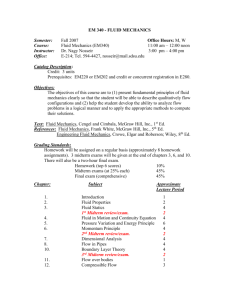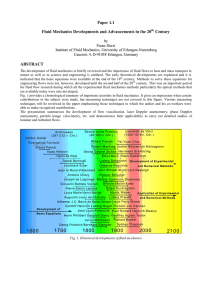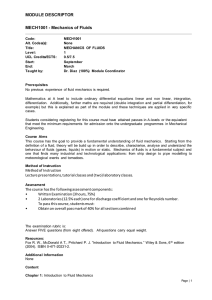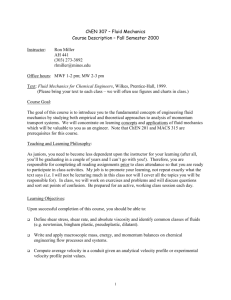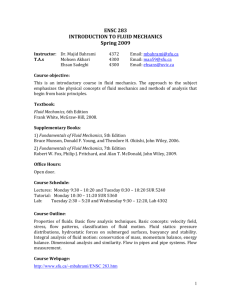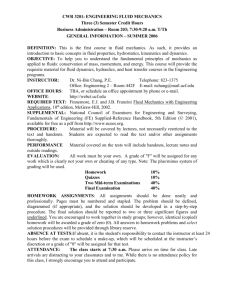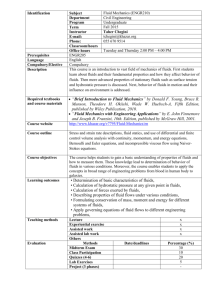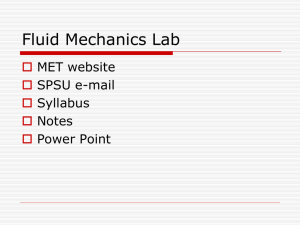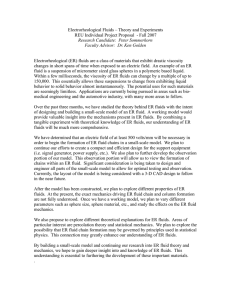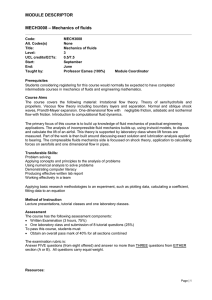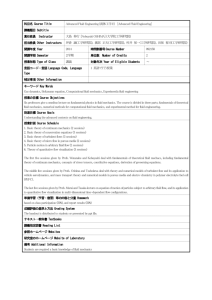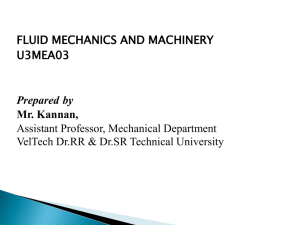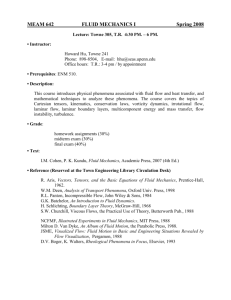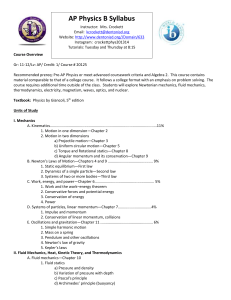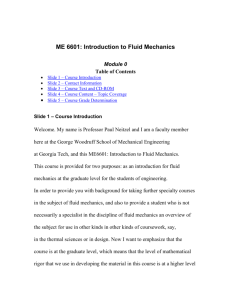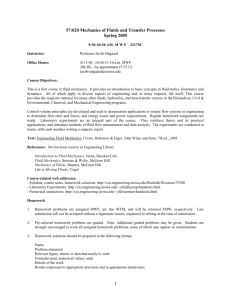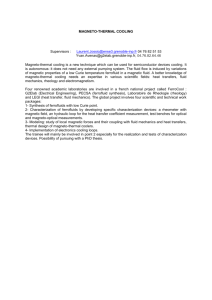Course Organization - Athanassios Z. Panagiotopoulos
advertisement
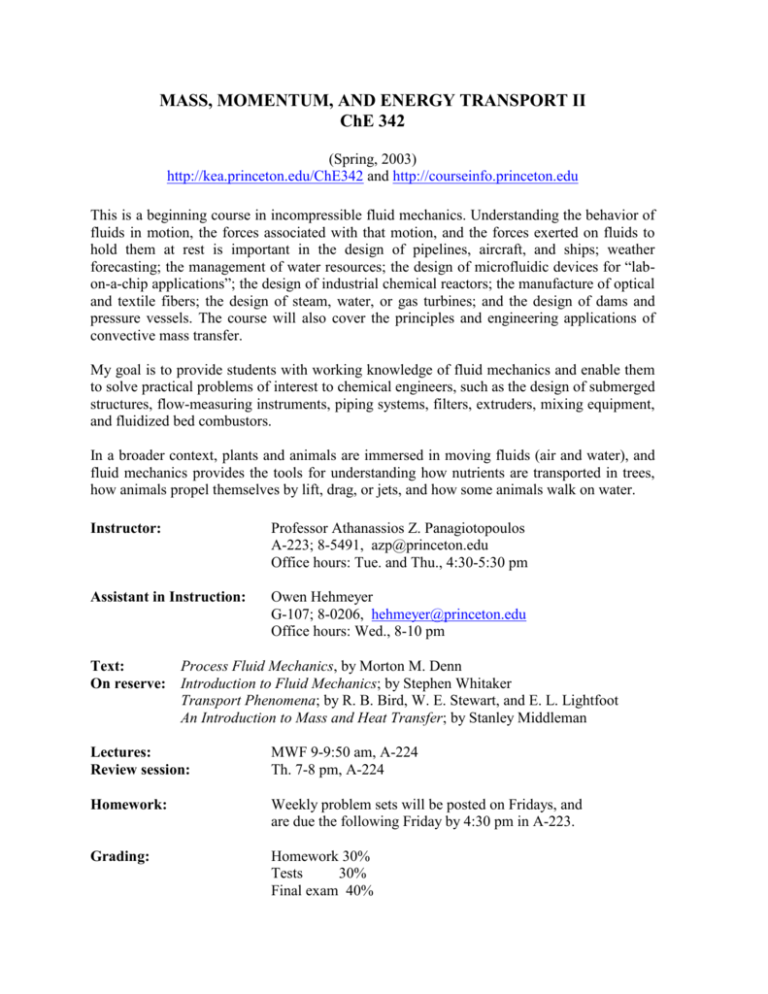
MASS, MOMENTUM, AND ENERGY TRANSPORT II ChE 342 (Spring, 2003) http://kea.princeton.edu/ChE342 and http://courseinfo.princeton.edu This is a beginning course in incompressible fluid mechanics. Understanding the behavior of fluids in motion, the forces associated with that motion, and the forces exerted on fluids to hold them at rest is important in the design of pipelines, aircraft, and ships; weather forecasting; the management of water resources; the design of microfluidic devices for “labon-a-chip applications”; the design of industrial chemical reactors; the manufacture of optical and textile fibers; the design of steam, water, or gas turbines; and the design of dams and pressure vessels. The course will also cover the principles and engineering applications of convective mass transfer. My goal is to provide students with working knowledge of fluid mechanics and enable them to solve practical problems of interest to chemical engineers, such as the design of submerged structures, flow-measuring instruments, piping systems, filters, extruders, mixing equipment, and fluidized bed combustors. In a broader context, plants and animals are immersed in moving fluids (air and water), and fluid mechanics provides the tools for understanding how nutrients are transported in trees, how animals propel themselves by lift, drag, or jets, and how some animals walk on water. Instructor: Professor Athanassios Z. Panagiotopoulos A-223; 8-5491, azp@princeton.edu Office hours: Tue. and Thu., 4:30-5:30 pm Assistant in Instruction: Owen Hehmeyer G-107; 8-0206, hehmeyer@princeton.edu Office hours: Wed., 8-10 pm Text: Process Fluid Mechanics, by Morton M. Denn On reserve: Introduction to Fluid Mechanics; by Stephen Whitaker Transport Phenomena; by R. B. Bird, W. E. Stewart, and E. L. Lightfoot An Introduction to Mass and Heat Transfer; by Stanley Middleman Lectures: Review session: MWF 9-9:50 am, A-224 Th. 7-8 pm, A-224 Homework: Weekly problem sets will be posted on Fridays, and are due the following Friday by 4:30 pm in A-223. Grading: Homework 30% Tests 30% Final exam 40% Course Outline Importance and applications of fluid mechanics. Properties of fluids: density, viscosity, surface tension. Newtonian and non-Newtonian behavior. Review of vectors and tensors. Fluid statics. Buoyancy. Archimedes' Principle. Forces on submerged objects. Kinematics. The material derivative. Material volume. Divergence theorem. Reynolds transport theorem. Stress and the stress tensor. Conservation of mass and momentum. Differential forms of the conservation laws. Bernouilli's equation. Macroscopic balances. Applications. The Newtonian fluid. The Navier-Stokes equations. Boundary conditions. Exact solutions. Poiseuille, plane Poiseuille, and torsional flows. Coating. Dimensional analysis. theorem. Pipe flow. Friction factor. Pumps and piping systems. Flow through beds of particles. Scaling and ordering analysis. Approximate solutions of the Navier-Stokes equations. The creeping flow approximation. Squeeze film problem, Stokes flow, Stokes paradox. The lubrication approximation. Coating, slider block. Stream function, vorticity, potential flow. Stagnation flow. Flow past a cylinder, d'Alambert's paradox. The boundary layer approximation. Flow over flat plates and wedges. The integral momentum approximation. Drag on immersed bodies and boundary layer separation. Entry length for laminar flow. Turbulent flow. Averaged form of equations of motion. Mixing length theory. Turbulent pipe flow. Friction factor. Convective mass transfer. Examples: falling film, coal combustion, fiber spinning. Film theory. Boundary layer theory. Mass transfer coefficients.

